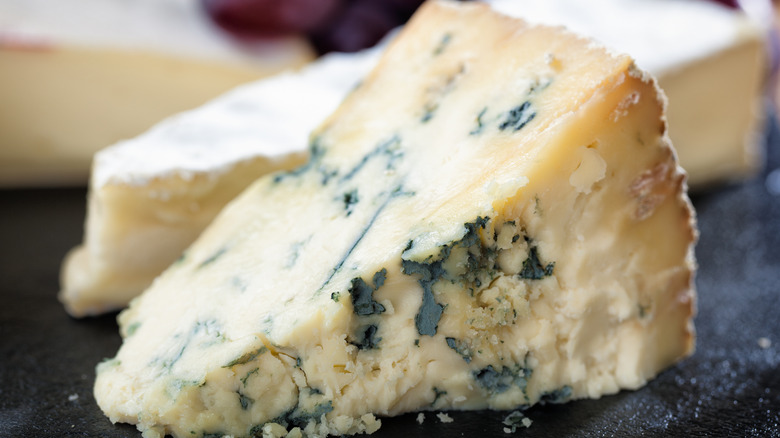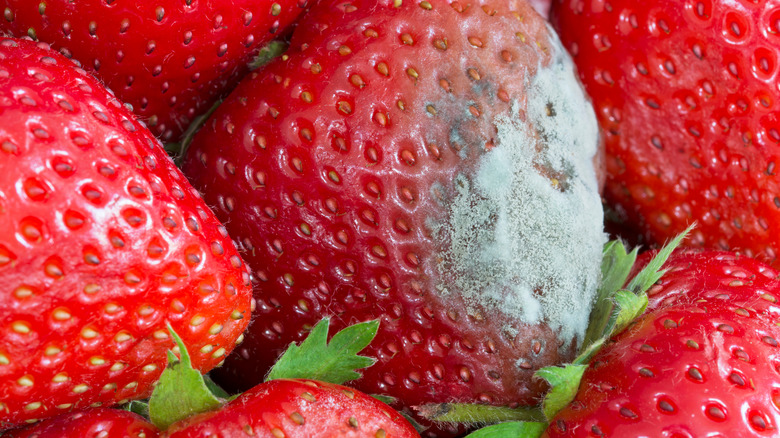Actually, Mold On Food Isn't Always A Bad Thing
Everyone has those moments when they looked forward to enjoying a treat they picked up from the grocery store the other day (or week) only to find a little furry mold growing. You may wonder whether it is okay to cut the mold off or whether it is dangerous. The answer varies depending on the food.
Sometimes mold is used in the production process, for example, Roquefort, Gorgonzola, Brie, Camembert, and Stilton cheeses all involve a type of mold that is considered safe to eat in the form of penicillium which is used to make certain antibiotic medicine. In this case, the mold enhances the texture and taste. People also use a little penicillium to dry-cure meats like Italian salami. Winemakers often use a mold called Botrytis cinerea, or "noble rot" as part of the winemaking process to dehydrate and sweeten the wine grapes. As a result, finished wine sometimes has a tiny amount of mold but it is usually within safe standards, according to the American Chemical Society.
Beyond some types of wine, cheese, and salami, there are some foods that are safe to eat if you remove and discard both the mold and an inch of the surrounding area since the mold has roots that run deeper than what you can see. The U.S. Department of Agriculture offers a detailed guide to which foods are safe and which are not. For example, you don't have to throw away low-moisture hard cheeses like Parmesan and hard vegetables like carrots once you discard the mold and the surrounding area.
Toss any foods with dangerous mold
While there are certain foods where mold is an important part of its production and others where you can safely discard mold, most of the time you want to throw away moldy food. According to the USDA, some molds produce poisons known as "mycotoxins" which can make you sick. It's most common in grain and nut crops, but moldy celery, grape juice, apples, and other produce can also create mycotoxins. To be safe, throw away any soft or high-moisture fruits and vegetables with mold.
The same applies to other high-moisture foods like most meat, yogurt, jam, cooked pasta, soft cheeses, berries, and just about everything else. As much as we hate to waste food, the safest choice is to discard those foods when they have visible mold.
Despite your best efforts to avoid ingesting mold, you may reach into your refrigerator to pull out those raspberries you just bought and start eating them only to notice one that is covered in furry mold. Don't panic, most likely the small amount won't hurt you. The Cleveland Clinic suggests that you pay attention to how you feel throughout the day and seek medical attention if you experience any symptoms since some molds are dangerous. Since some people are allergic to mold, individual responses vary.
Preventing unwanted mold growth
When preventing unwanted mold, be aware that mold is a tiny fungus and its spores are all around and even floating in the air, according to the University of Minnesota. Certain conditions encourage mold to grow. When you see mold, you are seeing the stalk that pokes out, but there is also a root under the surface, according to the USDA.
Most molds thrive in warm and humid conditions, though some will tolerate being in the refrigerator. To discourage unwanted mold, the USDA recommends keeping your home's humidity levels below 40%. They also suggest that you clean the surfaces in your refrigerator every few months using a solution of baking soda and water to remove mold spores. If you find mold on food in your refrigerator, inspect nearby foods for signs of it and clean surrounding surfaces. Since mold is all around, it can be in your dish towels and sponges, launder or discard any that have a musty scent. Finally, be aware that sometimes grocery store produce already contains mold. Inspect berries and other produce for visible mold before buying. By following these tips, you can avoid consuming unwanted mold even if you choose to indulge in Stilton or Italian salami.


